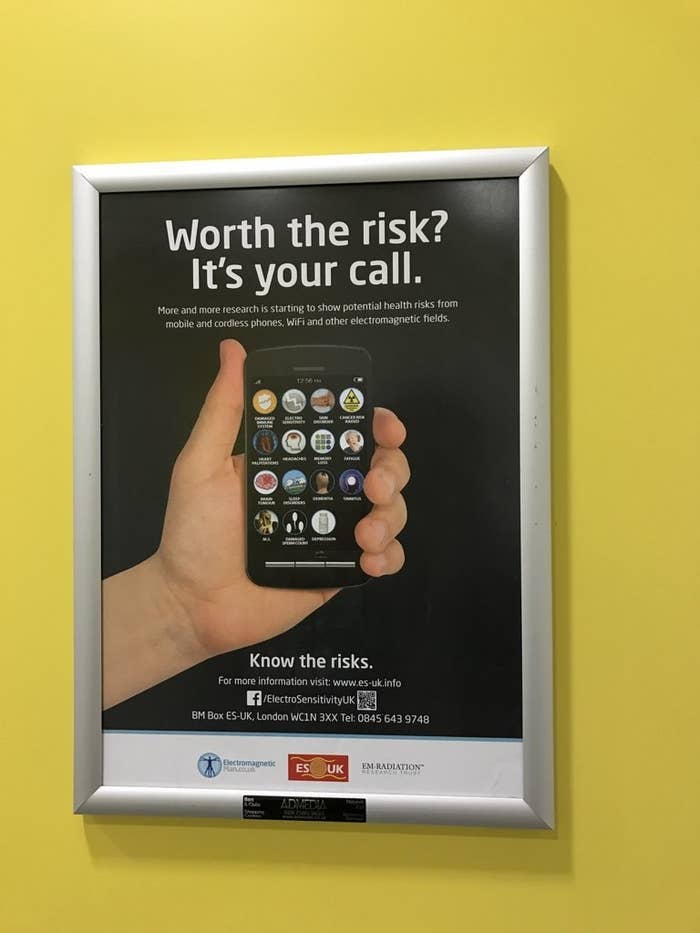
The Advertising Standards Agency says it is “assessing whether there are grounds” to investigate a registered charity’s adverts on display in London train stations, which claim that Wi-Fi and mobile phones are causing health problems.
Electrosensitivity UK’s adverts, which can be seen in King’s Cross and Waterloo stations in the capital, claim: "More and more research is starting to show potential health risks from mobile and cordless phones, WiFi and other electromagnetic fields.”
However, two scientists that BuzzFeed News have spoken to challenged this assertion, while the World Health Organization, Cancer Research UK, and the NHS all say that there is no good evidence that the sort of electromagnetic radiation (EMR) given off by phones and Wi-Fi routers is in any way dangerous.
“That’s the opposite of what the ‘more and more research’ is showing,” Dr David Robert Grimes, a physicist and cancer researcher at Oxford University who has investigated the electrosensitivity phenomenon before, told BuzzFeed News.
A spokesperson for the ASA told BuzzFeed News that the agency had “received three complaints about this ad and are currently investigating whether there are grounds to launch an investigation”.
“Electromagnetic hypersensitivity” (EHS) is a condition in which sufferers believe that Wi-Fi, mobile phones, and other low-power electromagnetic fields cause various ill effects, which, according to the WHO, include burning sensations, dizziness, nausea, and fatigue. Believers in EHS also claim that these fields raise the risk of cancers.

This is not the case, according to Grimes. “There have been several long-term studies which have shown no increase in glioma or other brain cancers with mobile phone use,” he said. “Electromagnetic radiation sounds frightening, but in reality it simply refers to different frequencies of light. Cell phones and Wi-Fi use microwaves, which have much lower energy than even visible light.
“Even the lowest-energy visible light carries roughly 1,430 times as much energy as the most energetic microwaves. Microwave radiation is completely incapable of direct DNA damage.”
Sufferers of EHS are experiencing real symptoms, said Grimes. But there is no good evidence to suggest that electromagnetic radiation is causing those symptoms. “There any many people who believe that Wi-Fi and other EMR makes them ill,” he said. “But while these beliefs are sincere, they appear misguided.
“In previous studies, sufferers of EHS reported ill-effect when exposed to sham EMR, and no ill-effect when exposed to real EMR without their knowledge. This would suggest the origin of the illness is psychological rather than physiological.
“This doesn't make it any less 'real' to sufferers, but suggests a different cause and course of treatment.”
Dr Laurie Phillips, a physicist at the University of Liverpool, told BuzzFeed News that he agreed: “Electromagnetic hypersensitivity has no scientific plausibility. Radio waves, as used by mobile phones, do not have enough energy to damage cells, and studies of electromagnetic hypersensitivity consistently find no link between radio waves and symptoms, with the few exceptions that do generally weak.”
ESUK’s adverts are not harmless, he said, adding that making worrying claims without adequate evidence is "dangerous, as it could result in symptoms of other problems being misattributed".
Michael Bevington, a trustee of Electrosensitivity UK, responded at length to a request for comment from BuzzFeed News, saying Phillips and Grimes were “simply wrong” to say the evidence did not support the existence of EHS and that their points were “inaccurate and misleading”.
He pointed to the World Health Organization’s International Agency for Research on Cancer’s 2011 decision to categorise “radiofrequency electromagnetic fields” as a “class 2B carcinogen”, meaning it is “possibly carcinogenic to humans” based on “an increased risk for glioma, a malignant type of brain cancer”. Bevington said “This supports the statement that ‘more and more scientific evidence is starting to show potential health risks’, unless you do not consider cancer a ‘health risk’.”
However, the classification just means that the link cannot be ruled out, and the threshold for "possibly carcinogenic" is low: Of the 1,063 substances and activities classified by IARC only one, a chemical called caprolactam, has been put in the lowest-risk class 4, “probably not carcinogenic”. Cancer Research UK said in a blog post at the time that “the published studies do not show that mobile phones could increase the risk of cancer. This conclusion is backed up by the lack of a solid biological mechanism, and the fact that brain cancer rates are not going up significantly.”
In a later post, Cancer Research UK said “the scientific evidence shows it is unlikely that mobile phones could increase the risk of brain tumours, or any other type of cancer. But we do not know enough to completely rule out a risk.”
Bevington also said in his email that the WHO’s International Commission on Non-Ionising Radiation Protection warned of a risk for “certain sensitive individuals” in 2002. However, the ICNIRP’s website says radiation from mobile phones is “unlikely to be associated with adverse health effects”.
He also said that “the weight of evidence of the science in this area has changed rapidly and convincingly in this area over the last decade”, that he was “unaware of a single medical expert in this area now denying the growing scientific evidence of adverse as well as therapeutic outcomes from low-level EM exposure”, and that the reality of EHS was now the “majority expert scientific viewpoint”.
However, BuzzFeed News was unable to find a single major international or UK health organisation that says there is strong evidence for negative health effects from Wi-Fi, although some countries, including France, have taken steps to reduce exposure to mobile phones and a court in Italy recently blamed a man’s tumour on his phone use. The WHO itself says: “To date, no adverse health effects have been established as being caused by mobile phone use.” The NHS says: “Research suggests it's unlikely that mobile phones or base stations increase the risk of health problems." Bevington says mobile phone companies have lobbied for the risks to be downplayed.
A 2013 Public Health England report said there is "no consistent evidence to date that exposure to radio signals from wi-fi and WLANs adversely affects the health of the general population". The European Commission says epidemiological studies have failed to find an association between EMR and cancer. The US Centres for Disease Control say: "At this time we do not have the science to link health problems to cell phone use."
Dr Simon Mann, head of Public Health England’s Radiation Dosimetry Department, said: “International guidelines are in place to limit public exposure to radio signals from mobile phones. There is no convincing scientific evidence that radio signals pose a risk to public health when they are below internationally agreed limits.”
